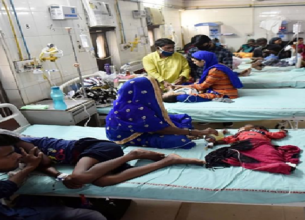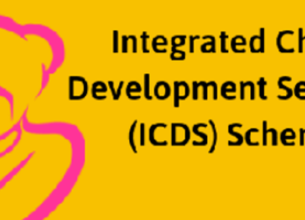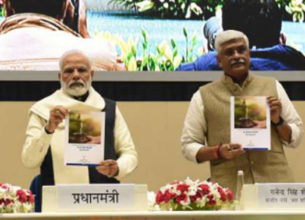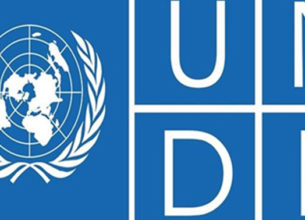KERALA TOPS NITI AAYOG’S SDG INDEX
31, Dec 2019

Prelims level : Growth, Development, National
Mains level : GS-III Indian Economy and Issues Relating to Planning, Mobilization of Resources, Growth, Development and Employment.
Why in News?
- Kerala tops states in progress towards UN Sustainable Development Goals, while Bihar is at the bottom of recently released NITI Aayog’s SDG Index.
About Sustainable Development Goals:
- The Sustainable Development Goals (SDGs) are officially known as Transforming our world: the 2030 Agenda for Sustainable Development.
- There are 17 Sustainable Development Goals, associated 169 targets and 304 indicators.
- They are universal call by United Nations Development Programme (UNDP) for action towards ending poverty, improving health and education, protecting planet, and ensuring that all people enjoy peace and prosperity by 2030.
- India has been closely monitoring its progress on SDGs through its National Indicator Framework and India SDG Index released in 2018.
About the Report:
- The SDG India Index was developed in collaboration with the Ministry of Statistics & Programme Implementation (MoSPI), Global Green Growth Institute and United Nations in India.
- The index comprises a composite score for each State and Union Territory based on their aggregate performance across 13 of the 17 SDGs (leaving out Goals 12, 13, 14 and 17).
- The score, ranging between 0 and 100, denotes the average performance of the State/UT towards achieving the 13 SDGs and their respective targets.
- The states were classified under 4 categories based on their scores. The states with scores between 0 and 49 were categorized ‘Aspirant’, between 50 and 64 were ‘Performers’, between 65 and 99 were ‘Front Runner’ and with a score of 100 were categorized ‘Achiever’.
- The aim of the index is to instill competition among States to improve their performance across social indices as the States’ progress will determine India’s progress towards achieving the set goals by 2030. Using the index, States will be monitored on a real-time basis.
Key Findings of the Report:
- Kerala ranked first in composite SDG index with score of 70. Kerala was followed by Himachal Pradesh, Andhra Pradesh, Telangana and Tamil Nadu.

- The biggest improvement was seen in states such as Uttar Pradesh, Odisha and Sikkim. The score of UP improved from 29 in 2018 to 23 in 2019. Also, the rank of Odisha improved from 23 in 2018 to 15 in 2019.
- The least performing states were Bihar, Jharkhand and Arunachal Pradesh.
- In terms of poverty reduction, states such as Tamil Nadu, Andhra Pradesh, Tripura, Mizoram, Meghalaya and Sikkim performed well.
- The states Uttar Pradesh, Assam and Bihar that were in Aspirant category moved to performers in 2019.
- The states that were in performer category in 2018 and moved to front runner include Andhra Pradesh, Karnataka, Telangana, Sikkim and Goa.
What is the Concern?
- Ending hunger and achieving gender equality are the areas where most states fall far short, with the all-India scores for these goals at 35 and 42 points respectively.
- The second SDG – zero hunger – shows sharp divergence in the performance of states, with little middle ground.
- Kerala, Goa and parts of the north-east — including Mizoram, Nagaland, Arunachal Pradesh and Sikkim – have scored above 65, with Goa at 75 points.
- However, 22 of the states and union territories have scored below 50, with the central Indian states of Jharkhand, Madhya Pradesh, Bihar and Chhattisgarh scoring below 30, showing abysmal levels of hunger and malnutrition.
- The chosen indicators are related to child stunting, obesity and anaemia, as well as agricultural production and subsidised food distribution.
- On the fifth SDG – gender equality – almost all states fare poorly. Only Jammu and Kashmir, Himachal Pradesh and Kerala have managed to cross 50 points.
- The indicators considered include crimes against women, eradicating sex selection and discrimination against daughters, and access to reproductive health schemes, as well as indicators showing women’s economic and political empowerment and leadership.
- A sex ratio of 896 females per 1000 males, a 17.5% female labour participation rate, and the fact that one in three women experience spousal violence all contribute to a low score countrywide.
- The Swachh Bharat Mission has contributed largely to the high scores on the sixth SDG – clean water and sanitation – although that was helped by the fact that four out of seven indicators dealt with toilets and sanitation, while only one indicator was related to safe and affordable drinking water.
- All states and union territories except for Delhi have scored above 65, with the national capital scoring poorly on the percentage of urban households with individual household toilets (less than one percent) and, oddly, providing no data on districts verified to be open defecation free.
- Delhi also has 81% of blocks with overexploited groundwater, vastly higher than any other state.
Way Forward:
- Unless development becomes a mass movement, India can’t achieve what it is essential as of now.
- India’s progress in achieving these goals are crucial for the world as it is home to about 17% of the world population, said a statement from NITI Aayog.















